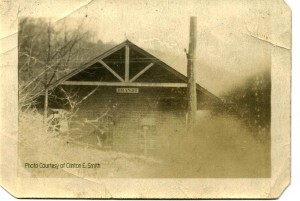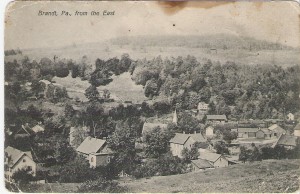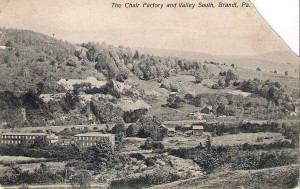A small passenger train slowly wends its way down the Jefferson Branch of the Erie Railroad, the engineer making a leisurely descent as he prepares to stop at Brandt Station. A few men are waiting with a load of quarry stone that has to be loaded; several milk cans are being kept cold on the back of an old wagon. The conductor quickly switches mail bags with the postmaster and two older ladies board the train. A man alights onto the wooden platform, he has the look and feel of “city” and in fact, he is “city”- an editor from Carbondale and he has come to do a piece about Brandt for his newspaper. As he walks down to stand on the wooden bridge that spans the Starrucca Creek, let’s join him there as he gathers his thoughts on how best to compose his story. And because it is his story, we need to let him tell it..
“Brandt’s Station on the Jefferson division is one of the places in this hilly country which is not calculated to make a favorable impression upon visitors who take their first view of the place from the depot platform. Directly opposite the station a rather dingy three-story structure looms up with bears upon its weather boards in huge letters, the legend “Brandt Chair Manufacturing Company”. A little to the left a group of smaller buildings may be seen, al bearing upon a smaller scale a similar legend. A few rods above the depot a wooden bridge spans the Starrucca Creek and a dilapidated looking blacksmith shop close by, completes the rather interesting first glimpse of Brandt’s.
The man who makes up his opinion of the village and the people who inhabit the place, from the first glimpse, will be forced to the conclusion later on that the old maxim, “first impressions are safest”, will not apply to Brandt’s. At least that was the conclusion which a party of Carbondale gentlemen arrived at after spending a few hours in the village on Saturday. The residence portion of the village completely hidden by the factory and the store buildings, and is not until on has crossed the stream and ascended the further bank that a view of the homes can be obtained.
The man who visits Brandt’s for the first time is treated to a grand surprise. Instead of a factory village, with its one story tenements that one naturally expects to see, he finds beautiful homes in the most charming homelike place in the world. The residence portion of Brandt’s is simply a beautiful park. The roadways are drives and the walks are free from the objections found by pedestrians in more pretentious places. Many of the dwellings are handsome modern structures and the entire park is filled with attractive homes. Near the entrance stands the church, a brick structure, handsomely finished and furnished, with a seating capacity for two hundred.
A little farther down the principal driveway stands the town hall which does service at all public gatherings. The building is new, of pretty design, and erected at a cost of nearly two thousand dollars. It contains a reading room, dining room and kitchen and on the second floor a commodious hall. This building is leased to the Young Men’s club at a nominal rental and every effort has been made to provide such elegant quarters for their use. Brandt’s industries are numerous and apparently profitable. The manufacture of chairs employs at present seventy-five men and boys. The chairs made at this establishment are among the finest made in this country. People who look with distrust upon factory made furniture, should visit these shops and see for themselves how substantially Brandt’s chairs are put together. The upholstering department is presided over by a gentleman who is master of the profession, and in the wood-making room several skilled carvers are employed who deftly transform the “oak wood” into life-like figures. Less than half a mile from the chair factory, down the stream, is located the brick yards where 25, 000 brick are made daily during the brick-making season. About the same distance up the stream from the village is located the tile and brick works which is the newest industry of the village. Here bricks are made that vie with the best grades f the Philadelphia article for smoothness. Paving brick which has withstood the severest of tests, and all manner of sewer pipe are also made at these works.
The clay deposits on the Brandt lands are the richest to be found anywhere. The mountains are filled with it and the pits at the tile works show that the clay bed is more than thirty feet thick. The supply is virtually inexhaustible and the men at the head of the brick-making enterprise have material for one of the largest plants in the world. The clay is free from sand and is fine enough when taken from the pits for use in the manufacture of all kinds of pottery. The Messrs. Brandt and Kessler, who own these industries, are pushing, enterprising gentlemen, and these industries, now in their infancy, will, we predict, within a few years attract the attention of the world by the superior quality of the ware made at Brandt’ tile and pottery works.”
The Tri-Weekly 9 Oct. 1890




